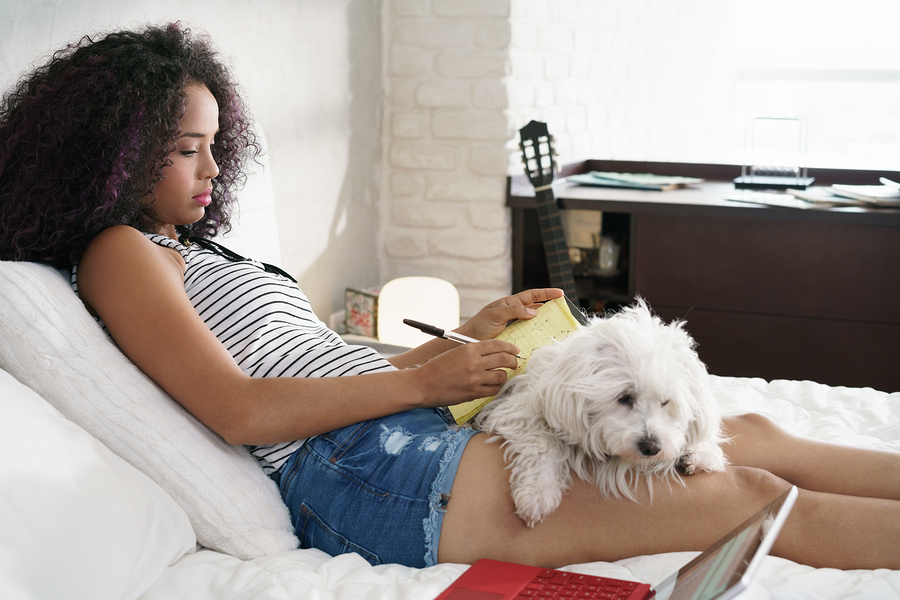At the start of the coronavirus pandemic when my state issued a stay-at-home order, a handmade sign appeared in a neighbor’s window that proclaimed: “AT LEAST OUR DOGS ARE HAPPY!”
Meanwhile, the internet exploded with memes of cats being unamused that their humans were cramping their style by invading “their” home so much.
Reality seems to be somewhere in the middle – for pets, it can be a mixed blessing to have us home all the time.
Lisa Radosta, DVM, DACVB, a board-certified veterinary behaviorist and Fear Free certified professional at Florida Veterinary Behavior Service in West Palm Beach, Florida, and correspondent for TopVetsTalkPets, says she can think of more cons than pros when it comes to how pets react to having their people around so much.
“The only positive I can think of is that you will notice things about the pet, whether it’s healthcare or a behavior change,” she says. “Being able to understand better your pet’s needs because you’re there more to observe.”
For example, we might notice that a dog sits in the window and barks at passing kids and cars all day, but neighbors never mentioned it. On the flip side, people can be pleasantly surprised to learn their cat doesn’t actually jump on the counter.
Because cats have the ability to be independent, she’s not as concerned about the negative effects of having people at home during the pandemic for them. But dogs have been bred to have a strong desire to be with us, so veterinarians are seeing an increase in separation anxiety.
However, Dr. Radosta’s biggest concern involves “COVID puppies.” Huge numbers of people adopted or purchased puppies during the pandemic for companionship, and she’s been seeing a lot of fear and aggression cases since they haven’t had normal socialization opportunities to help them get used to a variety of people, pets, noises, and environments.
“We’re seeing it all over the country,” she said. “These puppies just didn’t get out. They didn’t go anywhere.”
We All Need Some Space
With children at home instead of in school or at sports practice, dogs don’t get a break to nap or rest. So when kids are home and constantly wanting to pet or play with their pet, there are more opportunities for reactive responses, such as biting.
Radosta also noted that statistically, more fights occur between family dogs when the pet parents are home. Sometimes it’s overstimulation or competition for attention, or simply that because people are moving from room to room, there are more chances to interact or bump into each other.
There’s a potential for more reactivity and aggression as winter forces us inside even more.
Sadly, Dr. Radosta says that during the pandemic, behavioral euthanasia is “way up.” She’s concerned that 2021 will be the “year of relinquishment” as people surrender to shelters pets they didn’t socialize or train.
What can we do to avert this mounting crisis?
Socially Distant Socialization
If you have a puppy or are about to get one, get creative about socialization and get outside of your neighborhood.
“You’ve got to get the puppy in the car. You’ve got to take a walk somewhere. You can maintain social distance in a park or a parking lot. You could go walk at the strip mall,” Radosta says. “You can expose your puppy.”
Other ideas include hiring a positive reinforcement dog trainer with a facility where people can interact with your dog, and taking pets to a veterinary hospital, where the staff can handle and pet your pooch.
If you have adult dogs, separate them for part of the day. You can put up a baby gate and let them have time alone with a food toy. Similarly, if you have children, schedule “alone time” for dogs so they aren’t bombarded with attention. Give dogs a break from constant petting.
“It’s a lot to be with us all the time,” Radosta says. “So give them their space. If your yard is safe, put them in the yard without you.”
To reduce stress, Radosta recommends providing enrichment activities, from taking a walk or throwing a ball to playing nose work games or puzzling out food toys. Doggie daycare can also provide a change of pace.
Environmental enrichment will be key this winter when we’re inside our homes even more. Radosta just bought a cat tree for her kitty, and suggests going online to buy cat toys and possibly scented oils such as lavender (she notes that essential oils should never be placed directly on pets or in their food).
She hopes pet lovers will take steps to help their dogs and cats adjust to this new normal and not give up on them. Instead of relinquishing a pet to a shelter or having her euthanized, call a veterinarian or a veterinary behaviorist for help and advice.
“There’s always a solution,” Radosta says. “You may not know it now, but there’s always a fix for your dog or your cat. You’re not alone.”
This article was reviewed/edited by board-certified veterinary behaviorist Dr. Kenneth Martin and/or veterinary technician specialist in behavior Debbie Martin, LVT.








